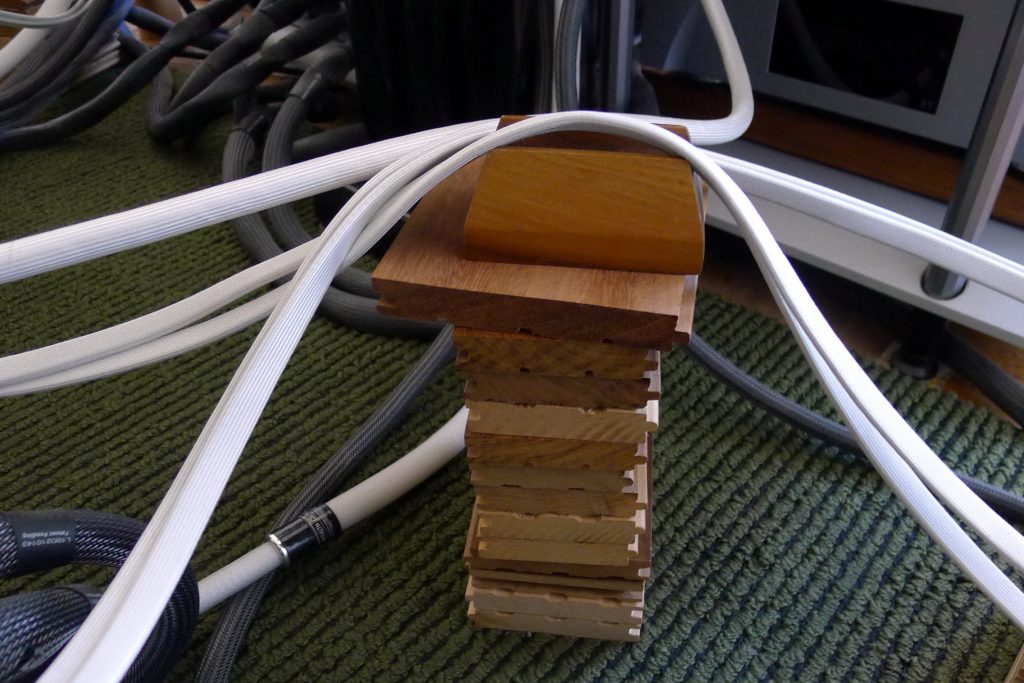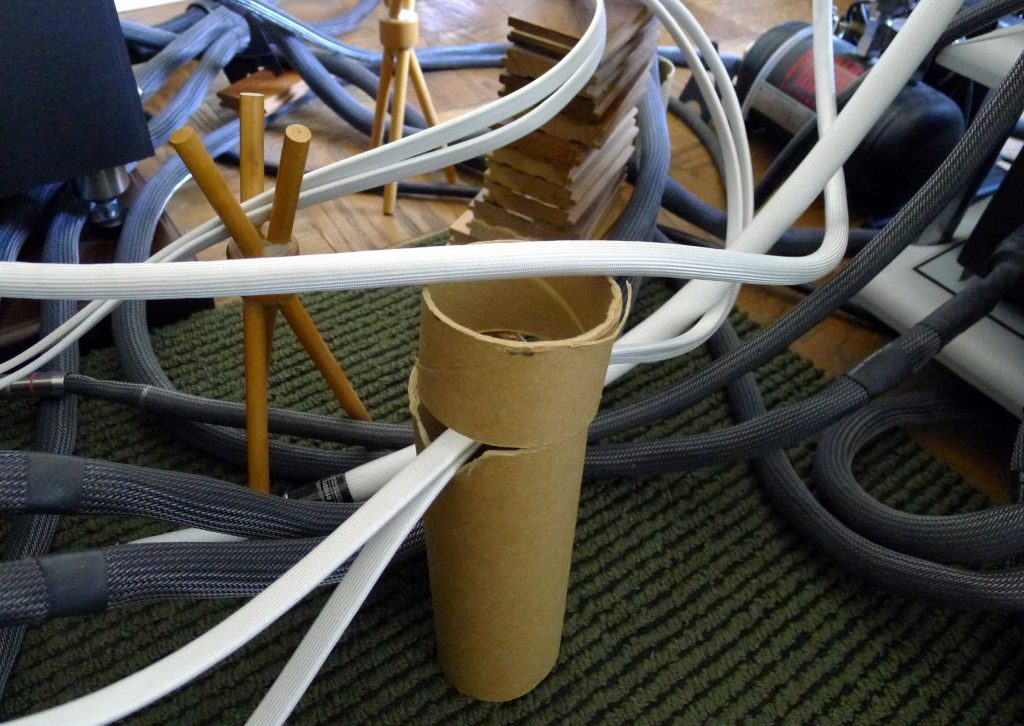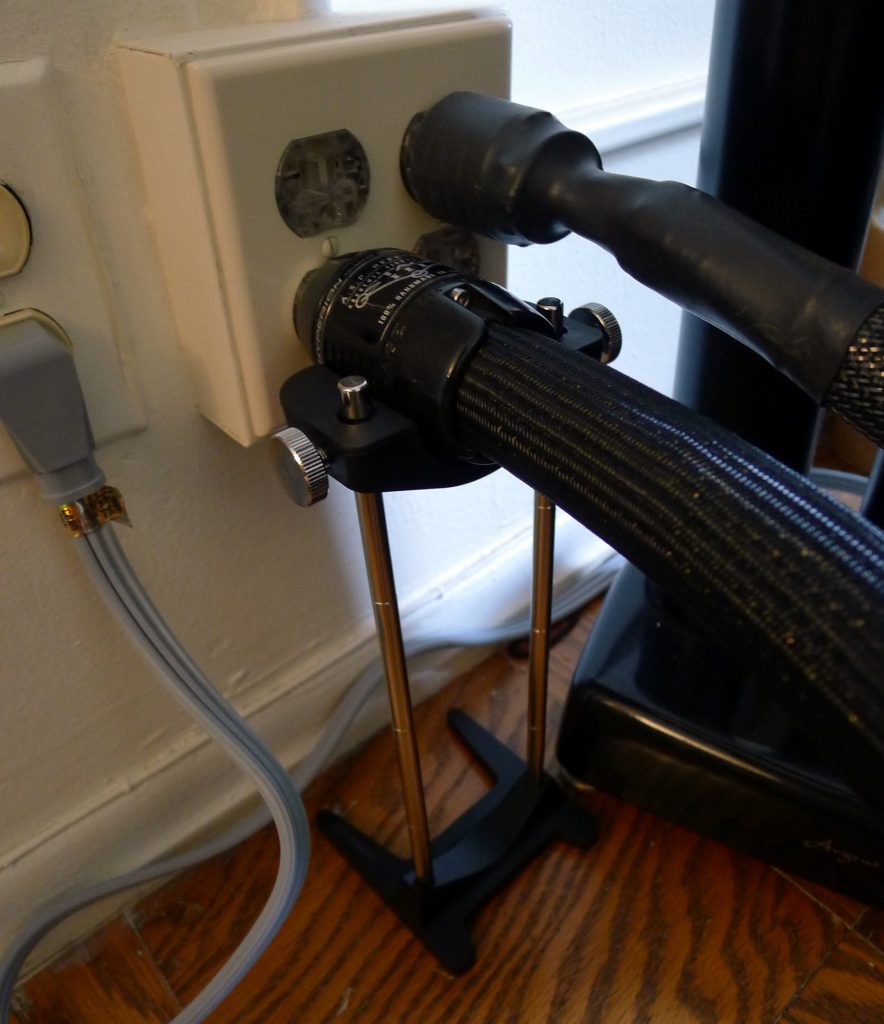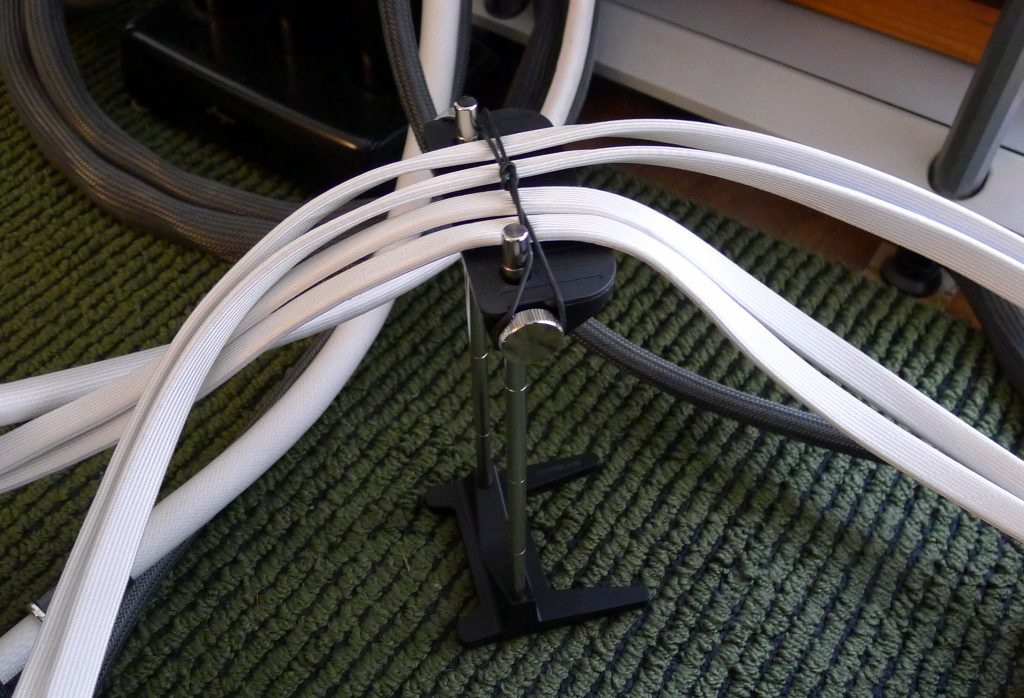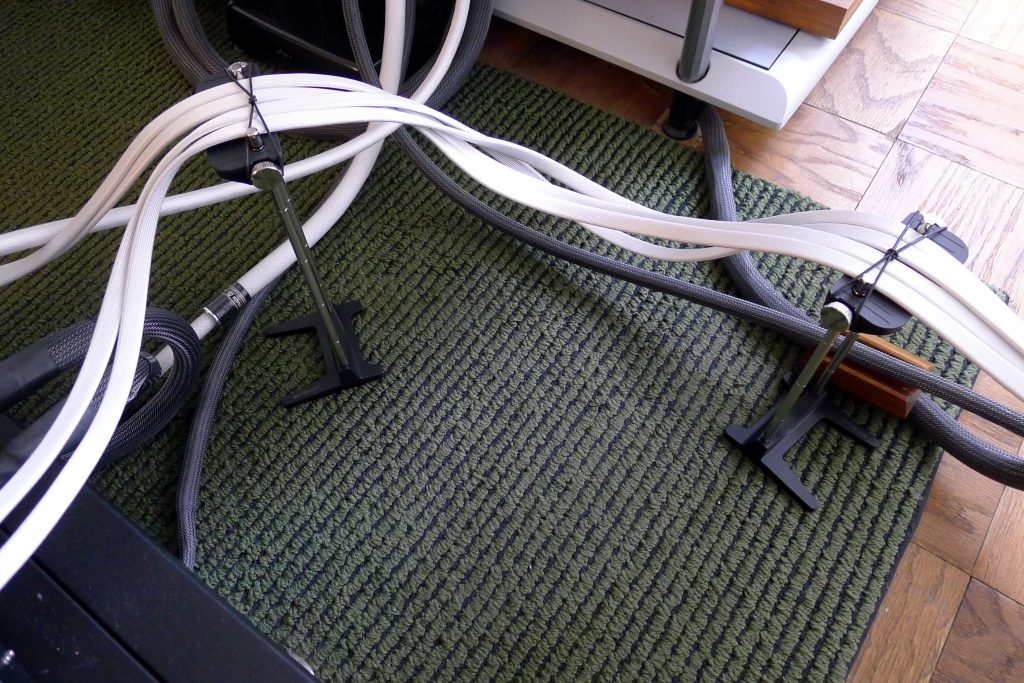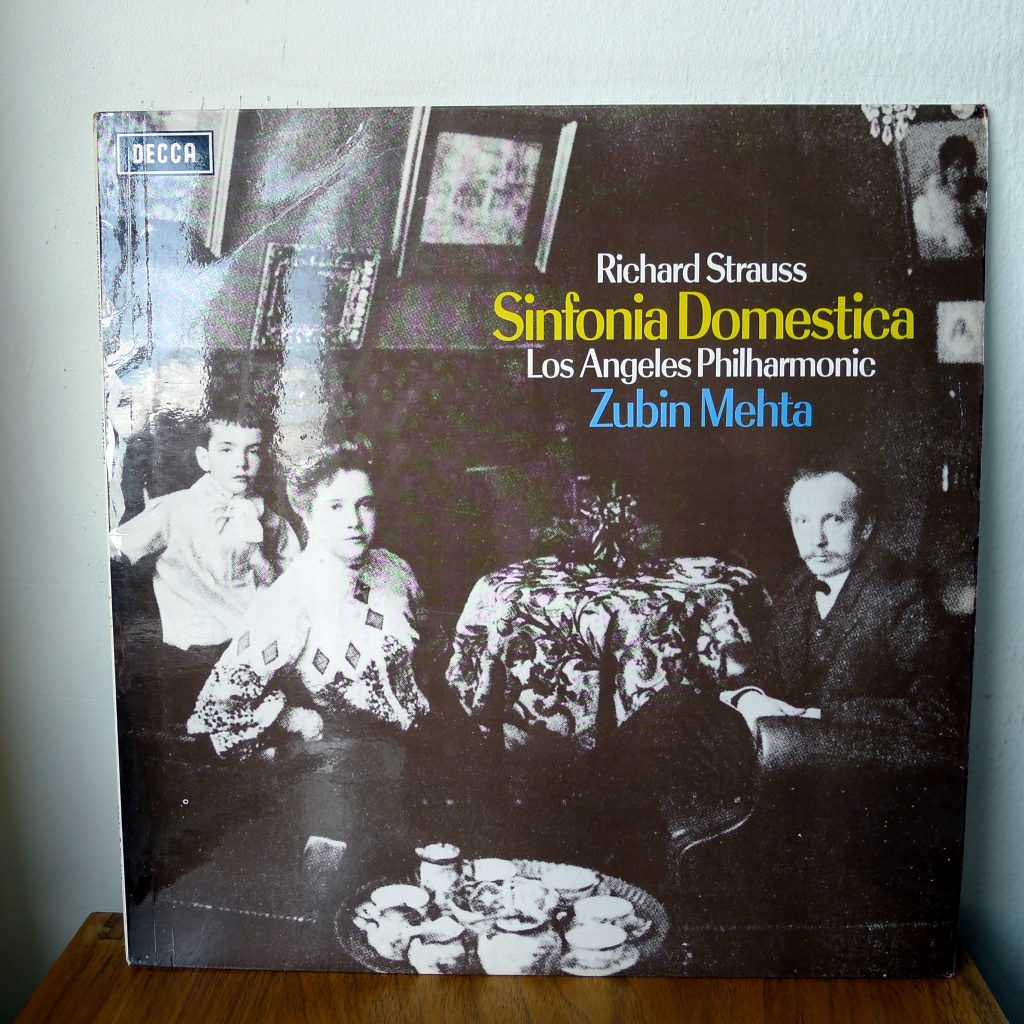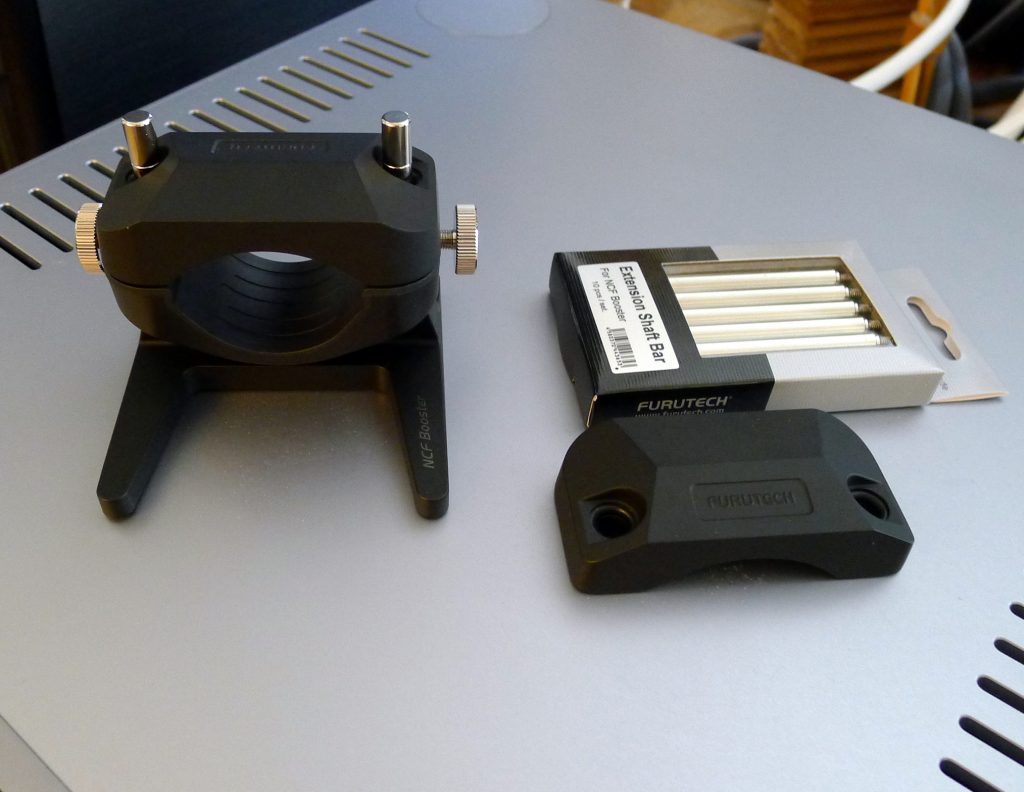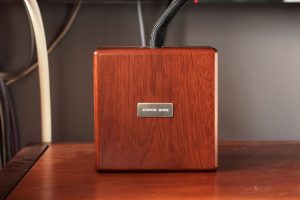Makeshift towers of stacked maple or walnut wood flooring samples support the wires to my amps
Take a look at my gallery of homemade cable supports. What a mess! I am embarrassed to show it. With a mid-six figure investment in gear, this is the best I could come up with? I've been looking for a cable management solution for as long as I've been involved in audio.
Proteus power cord to wall
Cardboard tubes of varying heights are used elsewhere. The heavy Proteus power cord from Stage III Concepts, which weighs in at 18lbs, is supported by one of these cylinders. This very shaky arrangement was actually the impetus for contacting Furutech about their NCF Booster, because it's an ideal candidate for a securing device.
Over the years as I've assembled this clutter, there was a method behind my mess, it was not random. Walnut and maple are tone woods. Walnut imparts a rich midrange; maple sweetens the treble. The cardboard tubes are straightforward neutral. My improvised supports actually sound better than most of the third-party cable lifts found on Audiogon for a reasonable price.
In a quick glance you'll understand the Furutech NCF Booster is made to order for the purpose, a great example of form follows function. But how much did you say they cost? $350 for a single cable support? (Sigh).
I shared this reservation with the importer, Scot Markwell of Elite Audio/Visual Distribution, who replied, "That's because they incorporate NF technology. Anything with that in it is going to be expensive." Then I went to their website to do some research on their nano technology, which they have patented and call NCF.
Nano Crystal2 Formula developed by Furutech features a special crystalline material that has two "active" properties. First, it generates negative ions that eliminate static. Second, it converts thermal energy into far infrared.
"Active" properties, you say? Well, I have no idea how negative ions and far infrared interact with components, only that it introduces uncertainty. I wasn't looking for an enhancement tweak. I needed a secure support between the cable and the wall outlet or component.
The Booster-AC for Power Cords
I began with the original Booster product for power cords (the Booster-AC), which went straight away under the Stage III Proteus to replace the cardboard tube. It certainly met my requirements for a secure, height-adjustable support. Build quality is exceptional; operation is silky smooth. Every aspect of the Booster exudes fine production values.
Cosmetics
I handed one to Sheldon to inspect and asked what he thought the MSRP might be. He fondled it some more, then guesstimated, "Maybe in the $1K area, based on the top-line Furutech AC outlets I recently purchased." When I informed him they were $350 each, a broad smile broke out. "Then these are quite the bargain. I want one… or two… or four."
Unexpected Results: The Audiophiles' Bugaboo
The introduction of that single Booster-AC to support the Proteus was not subtle. It unleashed such powerful damping and resonance suppression properties as to turn out the lights. The sound became dark, closed in, and over-damped.
Perhaps it was the interaction with the big Stage III Proteus? I moved the Boosters to my amps to support Kubala•Sosna Elation! power cords. Results were basically similar—slightly less damped, but still too much. I made several more attempts at other locations without any luck.
It gradually dawned on me that the Boosters effects overlapped with other room treatments I had in place. I use GIK acoustic absorption panels to address room resonances and Harmonix RFA-78i Room Tuning Discs on the walls to dial in the degree of soundstage focus I want. With a Booster added to the mix, both controls clearly went too far.
Now, don't ask me how it's possible that a cable support can have a similar effect as a large acoustic absorber or sharpen up images. It surely makes no sense. But then so much of real-world sound behavior in the listening room is non-conforming with the classic wave model we learn in school. I began to pull out these other tweaks; now the story-line changes.
The Booster-Signal
I'm glad the distributor included a few of the brand-new NCF Booster-Signal in my parcel. (The original product, simply called the NCF Booster-AC, is intended for power cables; the NCF Booster-Signal is for speaker wires, interconnects, etc.) They have a similar construction with the same mechanism to adjust height. However, the Booster-Signal has no top clamp over the cables and the supporting platform where the cables lay is flat. It also costs a lot less (MSRP $215).
Looking around for a good signal wire candidate, the CH Precision Reference Speaker Cables said, "I'm here." Two Booster-Signals went on each side. Again, it certainly provided the physically sturdy, secure support I was seeking. A side benefit was the improved appearance of my room.
There is no burn-in time required. With four Booster-Signals on the CH Ref speaker cables, the effects were immediate and—boy-oh-boy—deliriously good.
I cued up the Strauss Symphonia Domestica, with Zubin Mehta and the Los Angeles Philharmonic (SXL 6442). This is a prime example from the trove of reference recordings produced when Decca engineers collaborated with Mehta and the LA Philharmonic in Royce Hall. Symphonia Domestica is a heavily-scored work employing a huge orchestra that typically comes across in reproduction as a dense cacophony of sound. It has large blocks of commingled musical lines that are not individually decipherable.
It was certainly different now. First of all, things quieted down. The noise floor, which was already unnoticeable, dropped enough to make me notice it had dropped some more. And when instruments spoke, there was less brittleness or harshness around them. Damping and noise reduction were in play, but it wasn't overdone, it didn't shut down the treble, although it did make the presentation less lively.
With these distractions removed, the view was clean and focused—but not so clean as to be scrubbed—and an expansive soundstage unfolded back to the rear corners. Images were a tad stiff, not as loose and flexible. It was still sweet, but not as sweet; still warm, but not as warm. Dynamics got a nice kick.
When the listening panel next convened, they were dumbstruck by the magnitude of the effect. The thoroughgoing distortion-free view into the soundstage was so unexpected, the question was raised, "How could resting speaker wires on a platform have such an outsized impact?"
A Golden Opportunity
I scanned the room yet again for more candidates. Aha! The powered subs in my YG Anat speakers—everyone could use tighter bass, right? I put a Booster-AC under each K•S power cord to the sub amps.
Yes! It purged loose resonances so well I figured I'd top it off by inserting a Booster under the ICs to the subs as well.
No! The subs generate very little output, all at 65Hz and below (the YG Anat subs have a steep crossover at that point). It is surprising how they impact the way the entire spectrum sounds.
With the subs fully Boostered it became malnourished and tight. Removing the Booster-Signal from the ICs brought back rich and full sound. The lesson here is if you mess around with any frequency band, the listeners' impression of the whole is affected. It is so easy to overdo it in your zeal for higher resolution and clarity.
Booster Tips You Need to Know
The first Booster makes the most dramatic change. Subsequent ones build upon it, with diminishing impact. Resting the power cord on the lower platform of the Booster-AC gives you most of the effect. Adding the clamping top section compounds it. In a similar fashion, if the power cord's AC plug or collar rests on the Booster (rather than the soft dielectric part) it reduces the effect.
The Boosters don't have to be touching a wire to have an impact. You can hear the NCF effect if they are merely in the listening room around the gear area. I had to remove any unused Boosters to a storage area.
Since the NCF treatment is the same in both Booster models they sound alike. You could use one of the originals to support a signal wire and vice versa, if necessary. The Extension Shafts come in very handy. I used several sets to raise my speaker wires as far away from power cords as possible. That helps take off some of the treble edge.
Here's an amusing anecdote: One of my regular panelists brought another audiophile, who happened to be a physicist, along to a session. Ah, I thought, a good opportunity to get some perspective on this nano crystal stuff.
After I explained how the Boosters worked, his response "Why do you need to get cables off the floor?" left me sort of stunned. Good heavens, man, don't you read the audio magazines? I began to answer and then thought better of it. When I mentioned the NCF treatment, he asked, "Nano particles can make a difference in an audio product?"
"Well, let me do the A/B with the power cord for the subs," I suggested. Everyone heard the change as clear as day—except him. I was further dismayed when he insisted, "Power cables don't make any difference. I use the stock cords that come with the product." Again, I considered answering, but decided to let it go. You either hear it or you don't.
I loaned a quartet of Boosters to another friend who has a mid-level system. It didn't take long before he emailed me:
"I understand now why ‘booster' is the right word. They seem to boost the…favorable aspects of the sound spectrum, while purifying and reducing noise. From what I hear, they should be made an essential component to one's system. Which is to say they work dramatically well on mid-level systems."
Conclusion
A cable support needs to be both sturdy and height-adjustable. The Furutech NCF Booster products accomplish this admirably. They are perfect examples of form following function.
The kicker is they are coated with an "active" nano particle material called NCF that has the ability to change the sound. This is a hit or miss variable. In some applications, such as under my speaker wire, it works beautifully; in others it can be counterproductive. The only way to know is by trial and error.
The set of NCF Booster-Signals under my CH Reference Speaker Cable was so beneficial I purchased a pair of them. I'm also contemplating a pair of Booster-ACs for the powered subs in my YG Anat speakers.
Looking around my room, that leaves a lot of homemade, improvised cable supports still on the floor. I wish Furutech made a Booster product without the NCF feature. That I would buy a lot of.
NCF Booster
Retail: $350/ea
NCF Booster-Signal
Retail: $215/ea
Extension Shaft Set
Retail: $40/10 pieces
Furutech Co., Ltd.
Japan
USA Distributor
Elite Audio/Visual Distribution
Los Angeles, CA




